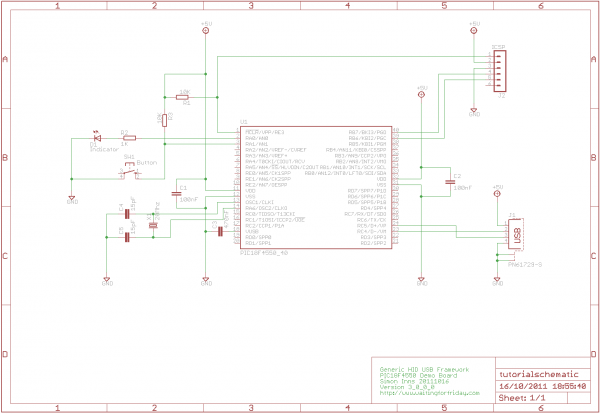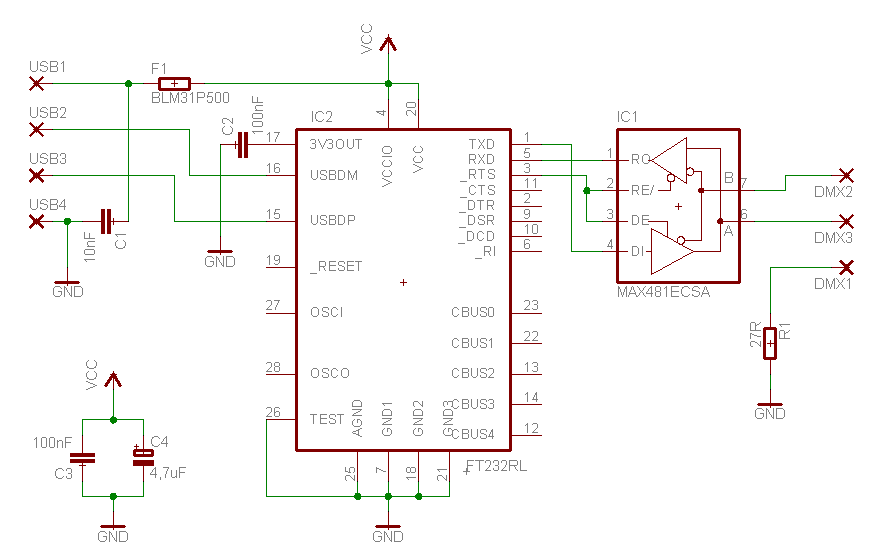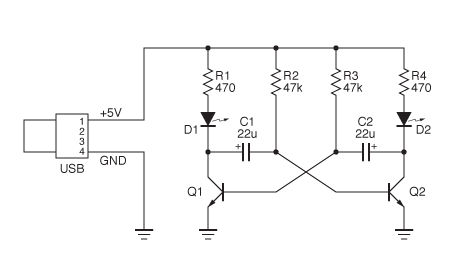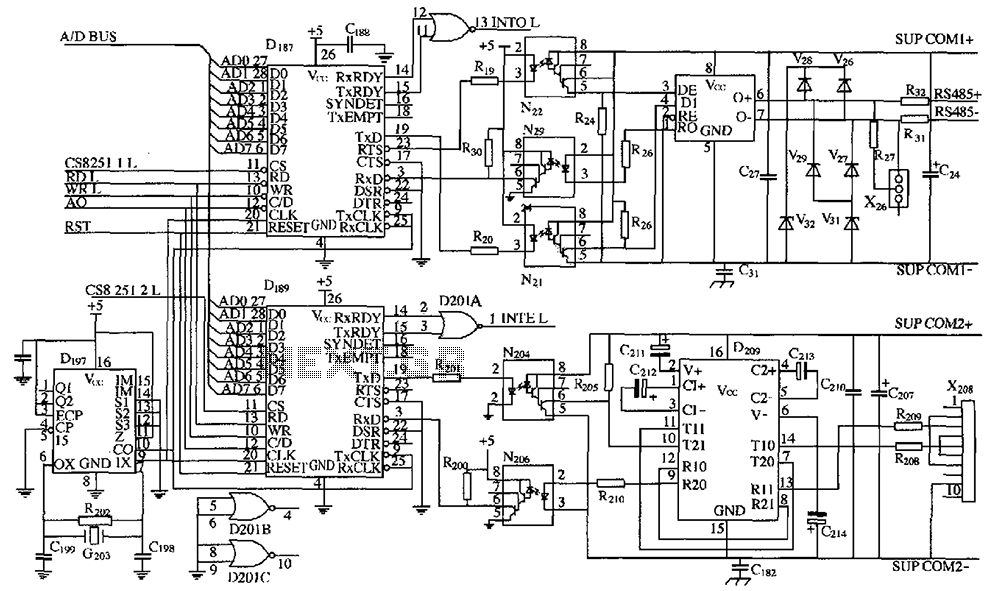
FT232 USB to Serial Module
.jpg)
This project utilizes the FT232XX chip series, which functions as a USB to serial converter. These chips are capable of converting USB protocol into asynchronous serial protocol, effectively allowing the transformation of a USB1 port into a corresponding serial port. However, it is important to note that these chips do not convert RS232 protocol to USB protocol; they serve merely as a bridge between the USB port and the connected device or project. Upon connecting the D+ and D- pins of the chip in a Windows environment, the operating system recognizes the USB device and automatically searches for the necessary drivers. FTDI provides these drivers free of charge for Windows users, which must be downloaded and installed as per the installation manual prior to utilizing the chip. Once the chip is connected to the USB port, Windows assigns a COM# port (for instance, COM4) that corresponds to the USB port. Any data sent in byte format to this COM port is redirected to the USB# port. This communication is bidirectional; if a byte is sent to the chip from a device, such as a typical microcontroller with a UART peripheral, that byte will be transmitted directly to the COM# port. The FT232 chip manages all data transmission and reception, making the process straightforward. To begin, a program that monitors the COM# port is required, and a recommended free program is available at a specified address. The operation is simple: the connection settings, including baud rate, port number, and parity, must be configured according to the specifications in the FT232xx datasheet. After establishing the connection by clicking the Connect button, the program interface is divided into two sections: Transmit and Receive. Any byte sent to the corresponding COM port will appear in the Receive section. Conversely, entering a character or string in the Transmit area and clicking the Send button will transmit the data to USB#, where it can be retrieved from the serial UART on the FT232xx chip. After gaining experience with the chip, it becomes apparent that it is highly beneficial for USB port-based projects and is cost-effective. While other companies offer USB to serial products, the preference for FTDI products is noted due to their comprehensive and user-friendly datasheets, as well as their widespread availability in electronic shops. FTDI also offers the option to purchase a module containing all necessary components to operate the chip, providing convenience and saving time. Initially, a single FT232BM chip was purchased, and a PCB was designed for mounting the chip to be used with breadboards, which proved to be a time-consuming endeavor but ultimately successful.
The FT232XX chip series operates by facilitating the conversion of USB signals to asynchronous serial signals, making it an essential component in various electronic applications. The chip's architecture includes a USB interface, a UART interface, and additional control logic that ensures seamless data transfer between the two protocols. The integration of the FT232XX in a project requires careful consideration of the power supply, typically provided through the USB connection, and the configuration of the UART settings to match the requirements of the connected microcontroller or device.
The FT232XX chip supports multiple data formats and baud rates, which can be configured through the associated software. This flexibility allows for easy integration into existing systems or new designs. The chip also features various pins that can be utilized for additional functionalities, such as RTS/CTS hardware flow control, which enhances data integrity during transmission.
When designing a PCB that incorporates the FT232XX chip, attention should be paid to the layout and routing of traces to minimize noise and ensure reliable communication. It is recommended to follow the guidelines provided in the FT232XX datasheet regarding trace width, grounding, and decoupling capacitors to achieve optimal performance.
Furthermore, the availability of development modules simplifies the prototyping process. These modules often come pre-assembled with the FT232XX chip and necessary components, allowing for rapid development and testing of USB to serial applications. The cost-effectiveness and ease of use of these modules make them a popular choice among engineers and hobbyists alike.
In summary, the FT232XX chip series provides a robust solution for converting USB signals to serial communication. Its user-friendly design, comprehensive documentation, and widespread availability contribute to its status as a preferred choice for USB to serial applications in various electronic projects.This project is based on USB to serial converter FT232XX chip series. These chips can convert the USB protocol to asynchronous serial protocol. In other words, you can use the chip for convert for example USB1 port to the correspondent serial port. These chips can`t convert RS232 protocol to USB protocol. They are just a bridge between your USB po rt and your project or device. After connection of pins of D+ and D- of the chip in windows platform, windows detects a USB device and searches for the drivers. The FTDI Company delivers all necessary drivers in Windows platform for free. You must download it from the page. After studying the installation manual, you must install the drivers. This must be done before application of the chip. If you connect the chip to the USB port after that, windows make a COM# port which corresponds the USB port, for example COM4.
Any data in byte format which is sent to this COM port is redirected to the USB# port. This action is reversible, if you send a byte to chip from your device for example by a typical microcontroller and UART peripheral, the byte will be sent directly to COM# port. All transmission and reception of data bytes is handled by the FT232 chip. It is very simple. For a start only thing you need is a program that monitors the COM#. I suggest you to use this program. This program is accessible from this address too: is a free program. The operation is very basic. you must first setup your connection setting for example Baud rate, Port Number, Parity, etc. The appropriate setting is delivered in FT232xx datasheet. Then open the port by click on Connect button. This program is separated into 2 parts: Transmit and Receive. Any data byte which is sent to the correspondent COM port is shown on Receive part. Vice versa, If you type a character or string in text box in Transmit area and click the ->Send button, the data will be passed to USB# and you can get it from serial UART on FT232xx chip.
After experiences with the chip you find it very useful in USB port based projects. The chip is also cheap. There is other companies which sell their USB to serial products, but personally I prefer using the FTDI products; the datasheets are very interactive and clear and ubiquities in all electronic devices shops. You can also buy one from FTDI eShop. FTDI sells these converters in surface mount devices. It also offers you to buy a module which has all necessary parts to run the chip. The prices and volumes are incredible! You can buy a module and save your time. First time I bought a single FT232BM chip. I designed a PCB to mount the chip on for using in breadboards. This took a lot a time for me to handle the matter but after all hardships, I managed the project. 🔗 External reference
The FT232XX chip series operates by facilitating the conversion of USB signals to asynchronous serial signals, making it an essential component in various electronic applications. The chip's architecture includes a USB interface, a UART interface, and additional control logic that ensures seamless data transfer between the two protocols. The integration of the FT232XX in a project requires careful consideration of the power supply, typically provided through the USB connection, and the configuration of the UART settings to match the requirements of the connected microcontroller or device.
The FT232XX chip supports multiple data formats and baud rates, which can be configured through the associated software. This flexibility allows for easy integration into existing systems or new designs. The chip also features various pins that can be utilized for additional functionalities, such as RTS/CTS hardware flow control, which enhances data integrity during transmission.
When designing a PCB that incorporates the FT232XX chip, attention should be paid to the layout and routing of traces to minimize noise and ensure reliable communication. It is recommended to follow the guidelines provided in the FT232XX datasheet regarding trace width, grounding, and decoupling capacitors to achieve optimal performance.
Furthermore, the availability of development modules simplifies the prototyping process. These modules often come pre-assembled with the FT232XX chip and necessary components, allowing for rapid development and testing of USB to serial applications. The cost-effectiveness and ease of use of these modules make them a popular choice among engineers and hobbyists alike.
In summary, the FT232XX chip series provides a robust solution for converting USB signals to serial communication. Its user-friendly design, comprehensive documentation, and widespread availability contribute to its status as a preferred choice for USB to serial applications in various electronic projects.This project is based on USB to serial converter FT232XX chip series. These chips can convert the USB protocol to asynchronous serial protocol. In other words, you can use the chip for convert for example USB1 port to the correspondent serial port. These chips can`t convert RS232 protocol to USB protocol. They are just a bridge between your USB po rt and your project or device. After connection of pins of D+ and D- of the chip in windows platform, windows detects a USB device and searches for the drivers. The FTDI Company delivers all necessary drivers in Windows platform for free. You must download it from the page. After studying the installation manual, you must install the drivers. This must be done before application of the chip. If you connect the chip to the USB port after that, windows make a COM# port which corresponds the USB port, for example COM4.
Any data in byte format which is sent to this COM port is redirected to the USB# port. This action is reversible, if you send a byte to chip from your device for example by a typical microcontroller and UART peripheral, the byte will be sent directly to COM# port. All transmission and reception of data bytes is handled by the FT232 chip. It is very simple. For a start only thing you need is a program that monitors the COM#. I suggest you to use this program. This program is accessible from this address too: is a free program. The operation is very basic. you must first setup your connection setting for example Baud rate, Port Number, Parity, etc. The appropriate setting is delivered in FT232xx datasheet. Then open the port by click on Connect button. This program is separated into 2 parts: Transmit and Receive. Any data byte which is sent to the correspondent COM port is shown on Receive part. Vice versa, If you type a character or string in text box in Transmit area and click the ->Send button, the data will be passed to USB# and you can get it from serial UART on FT232xx chip.
After experiences with the chip you find it very useful in USB port based projects. The chip is also cheap. There is other companies which sell their USB to serial products, but personally I prefer using the FTDI products; the datasheets are very interactive and clear and ubiquities in all electronic devices shops. You can also buy one from FTDI eShop. FTDI sells these converters in surface mount devices. It also offers you to buy a module which has all necessary parts to run the chip. The prices and volumes are incredible! You can buy a module and save your time. First time I bought a single FT232BM chip. I designed a PCB to mount the chip on for using in breadboards. This took a lot a time for me to handle the matter but after all hardships, I managed the project. 🔗 External reference





